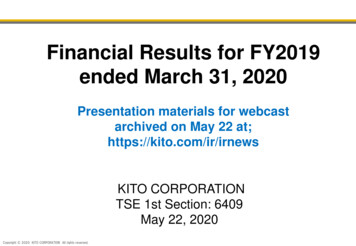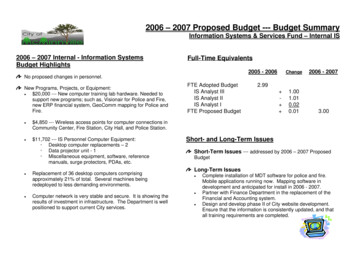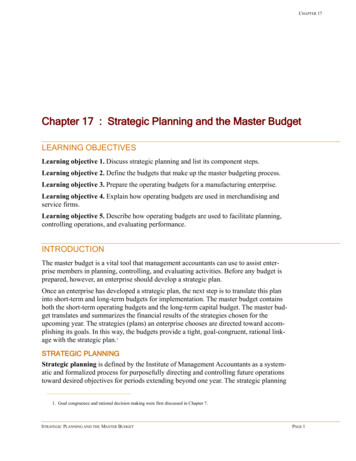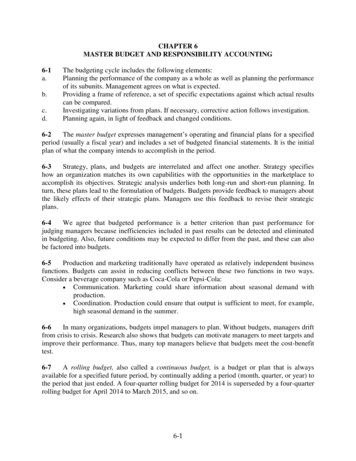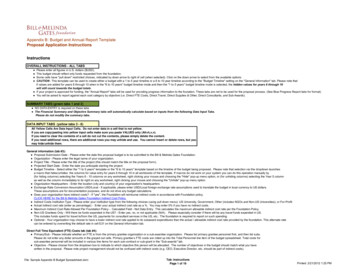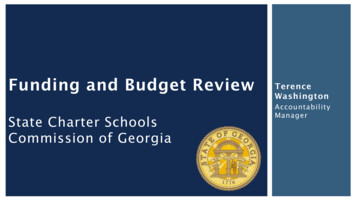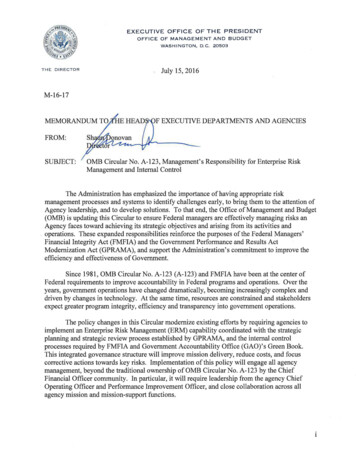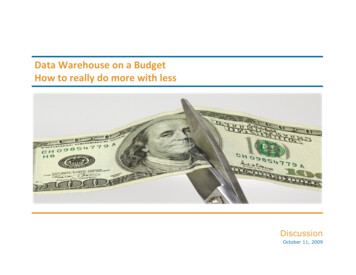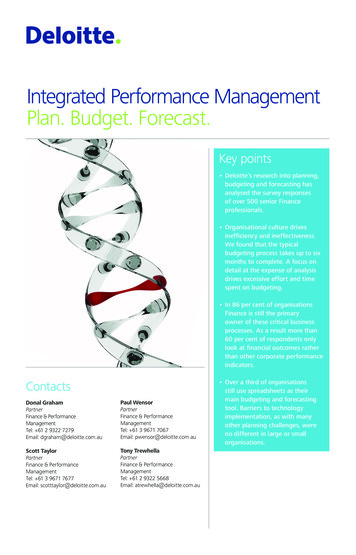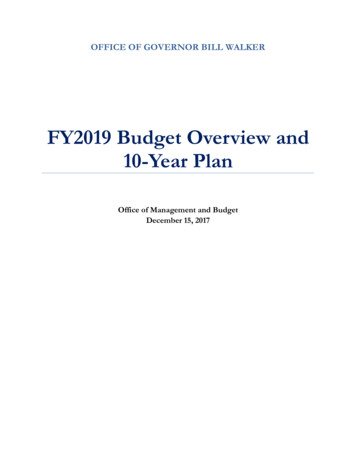
Transcription
OFFICE OF GOVERNOR BILL WALKERFY2019 Budget Overview and10-Year PlanOffice of Management and BudgetDecember 15, 2017
A Vision for Alaska’s FutureThe Walker-Mallott administration is releasing a budget for fiscal year 2019 that is designed torebuild confidence in Alaska and invest in our economy, bolster public safety, and work toward afiscal plan that protects the opportunities of future Alaskans.Although we have struggled in recent years to balance the state’s budget, we have the resources –natural, financial, and most importantly, human – to get through this rough patch and grow Alaska.Alaska is in a recession now, but our economy is the sum of individual decisions made by businessesand families based on how they feel about the state’s future. We must do what we can to bringstability and confidence to Alaska’s economy, safety to Alaska’s communities, and address long-termpublic liabilities and deferred maintenance.Public safety is a critical priority in this budget. If Alaskans don’t feel safe in their communities, theywon’t live, work or invest in them. That’s why we are including investments in public safetyresources in the budget to tackle crime and address the opioid and drug trafficking epidemic.Stable funding for education is another vital element in the budget. This is an investment in a criticalaspect of our economy – the future workforce. Safe streets and good schools build strongcommunities that make families willing to ride out tough times. Protecting these foundational publicservices creates opportunities for entrepreneurial Alaskans to invest, create private sector jobs, andgrow our economy.Balancing Alaska’s need for essential public services against a multi-year fiscal deficit means we needto run a smarter, leaner state government. The Walker-Mallott administration is continuing togenerate government efficiencies through consolidation and reform. State agency operating costshave already been cut 498 million between FY2015 and FY2018, and the state workforce hasshrunk by 2,800 employees between 2014 and 2017. The FY2019 budget continues to reduce thestate government workforce and no employees are receiving cost-of-living salary increases.Additionally, the administration is aggressively targeting health care costs in the state budget.Alaska has the highest unemployment rate in the nation, and we need to get Alaskans back to workbuilding Alaska. The construction industry has been one of the hardest hit during this recession –nearly one in five construction jobs in Alaska has disappeared over the past three years. The budgetincludes capital construction projects designed to get work started now – not in a decade after yearsof studies. The deferred maintenance projects proposed in the Alaska Economic Recovery Actaren’t simply make-work projects that will increase the state’s future costs. In fact, investing indeferred maintenance reduces future liability and conveys that the state is willing to take care of itsown assets – without growing the size of government.Our plan for working toward fiscal stability asks Alaskans to participate as co-investors in the effortby contributing through a limited payroll deduction tax that sunsets in three years. The proceedsfrom this tax will be used to fund the capital construction projects that will put Alaskans back towork now, and once Alaska’s economy is growing and the tax is no longer necessary, it will go away.Office of Management and Budget1Released December 15, 2017
Alaska must plan for a future with a smaller, more efficient state government that maintains a basiclevel of essential services and infrastructure that enable the economy to grow and prosper. This planensures we have the right tools to build a Stronger, Safer, and Smarter Alaska.Details for the fiscal year 2019 budget and the ten-year fiscal plan required under AS 37.07.020(b)(2)follow.Click here to move to the 2019 budget summaryStronger AlaskaAlaska Economic Recovery PlanThe Alaska Economic Recovery Plan will put Alaskans to work, address state and communities’growing deferred maintenance liability, and provide confidence to Alaska businesses and investors.The Governor’s deferred maintenance capital package will inject 1.4 billion of economic activity inconstruction projects throughout the state.The Alaska Economic Recovery Plan is comprised of three elements described in more detailthroughout this document: 1) the limited payroll deduction tax, 2) the Alaska Economic RecoveryAct, and 3) the oil and gas tax credit certificates bond financing program.The limited payroll deduction tax is a three-year 1.5 percent tax on wages and self-employmentearnings. The tax will generate revenue from residents and non-resident workers. The maximum taxis capped at twice the amount of the dividend and will sunset in 2021. This revenue will be used tofund the Alaska Economic Recovery Act, legislation to provide 800 million for deferredmaintenance work in 60 communities across the state over three years. This investment is contingentupon passage of the payroll tax.The Alaska Economic Recovery Act, submitted to the legislature, includes appropriations totaling 280 million in fiscal year 2019. It will be followed with appropriation bills of 270 million and 250million for fiscal years 2020 and 2021, respectively. Over that same period, the estimated revenuefrom the payroll tax will total 800 million, sufficient to fund the capital projects. This funding willleverage federal and local monies on top of state funds, amounting to a total of 1.4 billion ineconomic activity.This investment will address the University, K-12, and state facility deferred maintenance liability. Italso provides funding for deferred maintenance in communities, including a match for the Port ofAnchorage, and continues the harbor matching grants, bulk fuel tank and weatherization programs.The focus on deferred maintenance projects is designed to get work started now – not in a decadeafter years of studies. The deferred maintenance projects proposed in the Alaska EconomicRecovery Act aren’t simply make-work projects that will increase the state’s future costs. In fact,investing in deferred maintenance reduces future liability and conveys that the state is willing to takecare of its own assets.Office of Management and Budget2Released December 15, 2017
The Walker-Mallott administration takes immense pride in Alaska having one of the best trainedconstruction workforce in the country. By putting these skilled individuals to work now, they willstay in Alaska and the be ready for even bigger construction projects. With renewed certainty in theeconomy and a trained workforce up to the task, Alaska will be ready for future development, suchas the Alaska Liquefied Natural Gas Project, development of the Arctic National Wildlife Refuge(ANWR) ‘1002’ region, and other promising opportunities on the horizon.Oil and Gas CreditsTo encourage exploration and development on the North Slope, and in preparation for the openingof promising fields such as the Arctic National Wildlife Refuge (ANWR) ‘1002’ region and NationalPetroleum Reserve-Alaska (NPR-A), Governor Walker plans to use a debt-financing mechanism topay off oil and gas exploration tax credits more quickly than if we only made the statutory formulapayment to the industry.Oil companies in Alaska today are asset-rich but cash-poor. Smaller oil companies are sitting onbillions of dollars in untapped potential. Paying off these credits sooner gives oil companies thecapital necessary to make strategic investments that bring new fields online, create jobs, and buoythe state general fund with royalty and tax money to support government services.Thanks to the legislature preventing the state from assuming additional future credit liability with lastyear’s passage of HB 111, and the promising development opportunities on the horizon, theadministration wants to give the oil industry the certainty that they need to invest in futurepetroleum development. For many credit holders, the delay in payment has limited their ability toobtain financing for viable oil exploration and development projects. To reduce uncertainty, restoreconfidence and put Alaskans back to work, the administration proposes to buy back all credits at amodest discount.The state will finance this early, discounted buy-back by selling bonds. The debt financing cost overthe lifetime of the debt will be offset by the discount taken by oil companies who are eager toreceive their cash now, rather than on the schedule set by statutory formula. This makes the plandeficit-neutral, and it allows the state to make smaller debt payments up-front – a good thing duringa budget deficit.Click Here for More informationAlaska Liquefied Natural Gas PipelineA gasline will bring much needed economic development to the state, generating over 12,000 jobsfor Alaskans, and circulating 2 billion in the state economy each year. Completing the liquefiednatural gas pipeline project to ensure the earliest possible new revenue stream is a critical investmentin Alaska’s future fiscal health.With buy-in at the highest level, including the support of the Presidents of the U.S. and China, theAlaska LNG project is progressing forward. What makes this effort so promising is that, for the firstOffice of Management and Budget3Released December 15, 2017
time ever, Alaska has a customer. China is already Alaska’s top trade partner for seafood, minerals,timber, and energy. In just a few short years, China will be the largest consumer of natural gas in theworld, and they’ll be buying from Alaska.Financing structures are beginning to emerge as well. The Bank of China is developing a frameworkfor lending the state funds for construction of the pipeline. This is the fourth largest bank in theworld with a proven track record of financing LNG projects all over the world. The fiscal year 2019budget for Alaska Gasline Development Corporation includes authority to accept funds from thirdparty investors, but requires no additional state funding.A key priority for the administration is ensuring that natural gas is available to Alaskans, first andforemost. Gas will be sold all over the world, but Alaska residents will get the gas first and remainmajority owners of the pipeline.Maximizing Natural Resource Development OpportunitiesThe horizon holds many exciting opportunities for developing Alaska’s natural resources that willcreate jobs, grow Alaska’s economy, and generate additional state revenue. The Department ofNatural Resource’s oil production forecast incorporates many of these prospect fields, includingPikka, Nuna, Mustang, Greater Mooses Tooth, Willow, Moose Pat, Moraine and Liberty, on a riskweighted basis. The “high case” production forecast is meant to capture this upside potential in oildevelopment, representing an additional 150 million barrels of production over the next ten years,raising our production throughput in ten years by 100,000 barrels per day over current estimates,and producing 100 million more revenue annually at current price estimates. Additionally,excitement over recent discoveries is encouraging further exploration, which is likely to result ineven more discoveries over the next several years.The likelihood of an ANWR ‘1002’ area lease sale has increased dramatically over the past fewmonths as Congress has acted favorably toward this option. The ANWR ‘1002’ area is estimated tohold billions of barrels of oil and, once developed, has the potential to contribute hundreds ofthousands of barrels of oil per day to pipeline throughput. For reference, current base revenueestimates in the out-years assume 500,000 barrels of oil per day. Under the current federal proposal,half of the federal receipts from these ‘1002’ lease sales would accrue to the state.The mining sector is another place for optimism. Alaska is rich with valuable minerals; specifically,over a trillion dollars’ worth of gold, copper and zinc, plus significant amounts of rare earthminerals. Advancing prospects such as Donlin Gold and Livengood will reach production in thenext decade, creating thousands of good jobs for Alaskans and as much as 100 million in annualrevenues to the state.Office of Management and Budget4Released December 15, 2017
Safer AlaskaPublic safety is a critical priority in this budget. If Alaskans don’t feel safe in their communities, theywon’t live, work or invest in them. That’s why the budget includes investments in public safetyresources in the budget to tackle crime and address the opioid and drug trafficking epidemic. Publicsafety is a core function of government and needs to be swiftly addressed. That’s why the fiscal year2019 budget contains funding increases for public safety.Since 2011, crime has been steadily increasing across Alaska. Crime statistics from 2016, the mostrecent year available, starkly highlight the gravity of the ongoing public safety problem. To addressthese trends, Governor Walker tasked the state’s public safety agencies with evaluating the rise incrime and developing a Public Safety Action Plan. The plan focuses efforts on improving outcomesin the criminal justice system, identifying public safety resource needs, improving access to mentalhealth and substance abuse treatment, and addressing the opioid and drug trafficking epidemic. Withcurrent budgets and staffing, the public safety agencies can only be reactive, not proactive. Tocombat the root causes of the rise in crime, the state must build-up its public safety resources andcontinue to enhance both federal and local public safety partnerships, especially in rural Alaska.This budget funds the Public Safety Action Plan and other public safety initiatives with 34 millionin fiscal year 2019 to shore up critical public safety resources and build Alaska’s substance abusetreatment capacity. Rural law enforcement is a priority in the plan, and this budget calls for 3million in funding for enhanced trooper and prosecutor presence in rural Alaska. Crime statistics aregoing up, and although everyone in the state is feeling it, trends noted by the Department of Lawshow that rural Alaska has been hit particularly hard at a time when the number of sworn officersper capita is at a ten-year low. Anchorage has also been hit hard, with a record number of homicidesin 2017. That is why the budget also proposes adding two prosecutors to the Anchorage office.Beyond its rural outreach initiatives, the Department of Public Safety is establishing a crimereporting unit that will streamline the crime reporting process, make better use of trooper resources,and serve as a data-sharing hub for law enforcement agencies across the state to enhance interagencycommunication and coordination. Better crime data and analytics capacity will lead to betteroutcomes across the criminal justice and public safety systems – helping law enforcement becomemore proactive in combatting crime.Finally, the opioid epidemic requires acute intervention from both public health and public safetyagencies. This budget continues to fund a four-year 18 million grant program for expandingsubstance use disorder treatment capacity at the community level. This initiative aims to takeanother step in building out a comprehensive continuum of care for substance abuse treatmentservices, including outpatient services, intensive case management, residential treatment, medicallymonitored sobering centers, Medication Assisted Treatment (MAT), withdrawal management(detoxification) services and recovery support. Additionally, a prosecutor has been added inAnchorage to lead and coordinate statewide drug prosecution efforts. Because of the urgency of theOffice of Management and Budget5Released December 15, 2017
opioid crisis, the new statewide prosecutor was established this year, which took resources awayfrom other types of prosecutors. To continue these statewide drug prosecution efforts, a newposition in the Anchorage area is funded in the fiscal year 2019 budget.Public safety is a critical budget priority and will remain an area of investment in future years,particularly as the opioid epidemic spreads. The Public Safety Action Plan initiatives and otherpublic safety funding will provide a solid foundation to building a safer and stronger Alaska.Criminal Justice and Public Safety Spending Plan ( thousands)FY2019FY2020Department of Public Safety 3,650.6 2,500.0Department of Law 1,163.2 500.0Department of Corrections 10,447.6 8,000.0Department of Health and Social Services 18,000.0* 10,000.0*FY18 supplementalDepartment of Administration 453.5-FY20201 2,500.0 500.0 8,000.0 5,000.0-Health CareThe Walker-Mallott administration is aggressively pursuing strategies to reign in health care costgrowth in the state budget while ensuring state employees and public assistance beneficiaries haveappropriate access to quality care. Health care spending has been one of the largest and fastestgrowing areas in the state budget, and cost containment efforts continue to ensure that the risingcosts of health care don’t displace other spending priorities.AlaskaCare InitiativesThe AlaskaCare employee plan realized significant savings in 2017 by modestly increasing employeepremiums, adjusting plan benefits and pursuing greater provider discounts. State contributions toemployee health plans will remain flat in calendar year 2018 because of these changes. Further costsaving measures are slated for the 2018 plan year, continuing downward pressure on employeehealth costs.The AlaskaCare retiree plan will implement the Medicare Part-D Employer Group Waiver at thebeginning of the 2019 plan year, which increases the Medicare subsidy to the retiree health plan forprescription drug coverage. This change is estimated to result in significant savings to not only theretiree health trust, but also to the state payment to PERS/TRS retirement accounts. Preliminaryestimates indicate that these savings will amount to 25.5 million in fiscal year 2019 and up to 51million in subsequent years.Office of Management and Budget6Released December 15, 2017
Potential Health Care Budget Cost AvoidanceProjections (millions)Baseline State Health Care Budget Projection(current trend 5.2%) FY20191,414.0Sustainable State Health Care Budget Projection(inflation 2.25%)Savings needed (sustainable - current): 1,414.0Cost avoidance strategiesImplement EGWP CY2019Health Care Authority savingsMedicaid enrollment declines as economy recovers (20.0)FY2020 1,487.0FY2021 1,565.0 1,445.8 1,478.3 (41.2) (86.7) (50.0)(10.0) (50.0)(20.0)(10.0)MedicaidAlaska’s Medicaid program provides essential health coverage to low- and moderate-incomeAlaskans. With nearly 200,000 lives covered by the program, Medicaid is the biggest health plan inAlaska and a critical element of the state’s health care system. Medicaid is also one of the largestcomponents of the state budget; a trend that is common across all states.Medicaid enrollment has grown substantially in recent years driven by two concurrent and equallysignificant factors: Medicaid expansion, which broadened eligibility requirements for adults; andAlaska’s statewide recession, which heightened demand for social assistance as families suffer fromslow business, reduced work hours and lost jobs. Because the federal government pays for nearly allof services covered by Medicaid expansion, recession-driven growth in the regular, non-expansionMedicaid program has been far costlier to the state treasury.In 2016, the administration partnered with the legislature to pass extensive reforms to the Medicaidprogram designed to drive efficiencies, improve program outcomes and reduce the per-enrollee costof care. Although enrollment growth has driven up total costs for the program, reformsimplemented by SB74 and other efficiency measures resulted in over 100 million in avoided costsin fiscal year 2017. These savings are expected to grow as the Department of Health and S
Dec 15, 2017 · Balancing Alaska’s need for essential public services against a multi-year fiscal deficit means we need . from the payroll tax will total 800 million, sufficient to fund the capital projects. . The Walker-Mallott administration takes immense pride in Alaska having one of the best trained construction workforce in the country. By putting .
